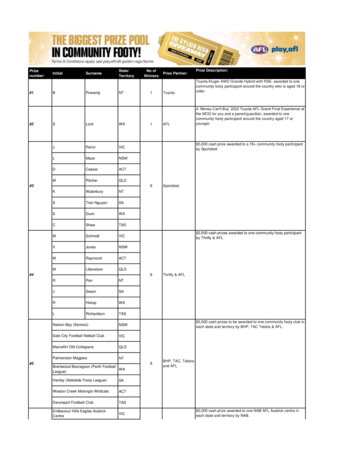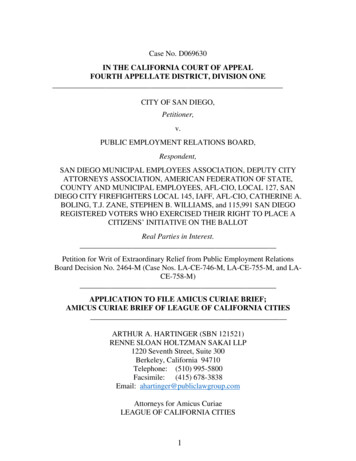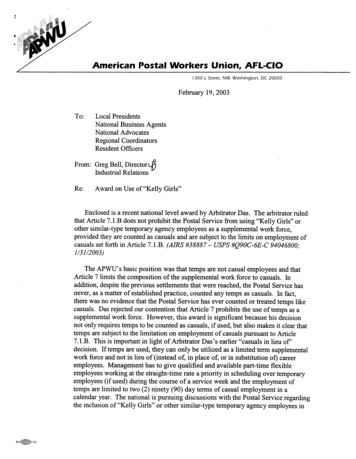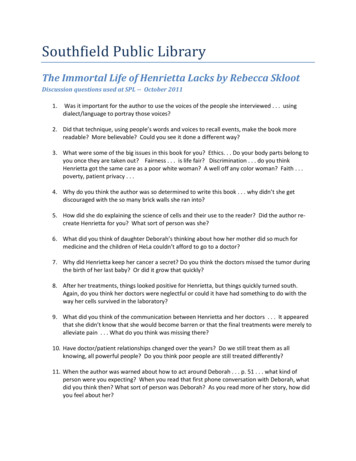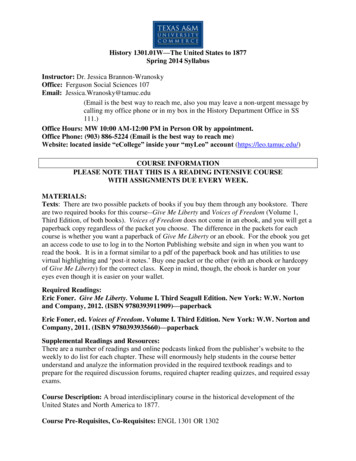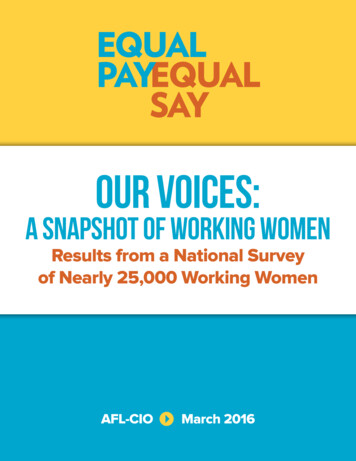
Transcription
EQUALPAYEQUALSAYOur Voices:A Snapshot of Working WomenResults from a National Surveyof Nearly 25,000 Working WomenAFL-CIO I March 2016
Working Women Speak OutMORE THAN 6.8 MILLION WOMEN in the UnitedStates are part of a union. Our mission at theAFL-CIO is to give each one a voice on the job, inthe economy and throughout our democracy.took time out of incredibly crowded schedules to fillout this survey. We hear you. The results will guidethe AFL-CIO working women’s policy agenda andpolitical action plans.Last fall, as part of that mission, we launched acomprehensive survey to better understand theexperiences and aspirations of working women.The National Survey of Working Women capturesa multifaceted picture of our lives.And the message is loud and clear. Working womenunderstand that our growing role in the workforcecarries new responsibilities—financial responsibilities,for example, as heads of households, and decisionmaking responsibilities in our homes, communitiesand jobs. We embrace these responsibilities as partof making progress. What we don’t accept—whatwe have to stop accepting—is the price societydemands from us in return.The survey is more than just a job assessment. Itzeroes in on how working women spend time athome, tackle financial challenges and engage inour communities. The results paint a clear pictureof the economy and society working women arecommitted to building.We sent the survey out to our networks of AFL-CIOunions, state and local labor coalitions, and communitypartners. We reached out to working women viaFacebook, Twitter and text message. Nearly 25,000working women responded in just six weeks.We received so much information about workingwomen’s priorities, day-to-day experiences,challenges, aspirations and commitments that wedecided to release our findings in a series of shortreports over the next few months.In this first issue brief, we’re presenting a snapshotof our entire sample: the economic conditionsworking women face, key issues and what drives usto action. Later briefs will examine young women,mothers, women of color and other topics thatprovide a further window into our experiences.I want to thank the thousands of working women,moms, daughters, grandmothers and sisters whoOUR VOICES: A SNAPSHOT OF WORKING WOMENAnd, luckily, working women are a formidableforce. Together, we can make issues like equalpay, paid leave and fair scheduling the law of theland. Together, we can raise wages and create aneconomy that gives all of us—women and men—the opportunity to work for a better life. Together,we can build an America where all working womencan sustain our families and realize our dreams.Finally, thank you to the AFL-CIO ExecutiveCouncil Committee on Women Workers, especiallycommittee Vice-Chair Diann Woodard, the staffwho helped produce this survey and, in particular,AFL-CIO Civil, Human and Women’s Rights DirectorCarmen Berkley and Sheva Diagne, programcoordinator of the Civil, Human and Women’sRights Department. Thanks also to the many peoplewho worked hard to bring this report to life and givea voice to working women every single day.In Solidarity,Liz ShulerAFL-CIO Secretary-TreasurerAFL-CIO 3
Our Voices: A Snapshot of WhatWorking Women WantTHE NATIONAL SURVEY OF WORKING WOMENhas captured the priorities of nearly 25,000 workingwomen who are politically engaged and poised totake action in their communities, their unions andat the voting booth. The union members surveyedare highly involved in union activities. Half (50%)consider themselves active in their unions, 35%regularly attend union meetings, 46% regularly talkto their co-workers about union matters and 18%hold an official leadership position in their union.More importantly, the vast majority of these women—union and nonunion—are politically engaged: 92%report they are registered to vote, 88% voted inthe last presidential election and 90% plan to votein 2016.A few key findings emerged from their responses:I Women are poised to take action on the coreeconomic issues that impact their lives, and theissue that motivates them the most—acrossgenerations and demographics—is equal payfor equal work.I This should not be surprising since the womenin our sample are the financial decision makersand breadwinners of their households. Almost60% report that they earn over half of theincome for their entire household and 87% saidthey held primary responsibilities for day-to-dayfinancial decisions in their household or sharedthe responsibility equally with a spouse orpartner.OUR VOICES: A SNAPSHOT OF WORKING WOMENI Working women are stretched thin. Over athird of our sample reported working over 40hours a week and 23% reported having towork mandatory overtime. One in five workedtwo jobs. A quarter said their schedules wereunpredictable and almost one in five saidthey sometimes had too few hours. Althoughunionized working women had significantlybetter wages and benefits than the nonunionrespondents in our survey, women of every ageand demographic group reported that equalpay for the work they do would be the changethat would most improve their lives.Our SampleA total of 23,215 women responded. By design,our survey was heavily skewed toward unionmembers. In the overall workforce, only about11% of women are union members.1 Two-thirds(67%) of the women who responded to our surveywere union members. Our sample included moreprivate-sector employees (53%) than public sectoremployees (43%), even though overall, 54% ofunion members are employed in the public sectorand 43% in the private sector.Respondents were asked to identify the type ofwork they do by selecting from a list of 20 industryand occupational categories. About 28% of allrespondents reported that they were in office oradministrative work; 22% worked in education;AFL-CIO 5
11% worked in health services; 10% worked in artsand media; 10% worked in community and socialservices; and 7% worked in retail. These proportionswere roughly the same for union and nonunionrespondents. The overwhelming majority (80%) ofrespondents were classified as direct employees,with a reported 11% as independent contractors, 6%on-call workers and 4% temp workers (both agencyand direct hire).SECTOR, ALL RESPONDENTSUnknown 4%PrivateSector53%6 AFL-CIOPublic Sector43%According to 2015 U.S. Bureau of Labor Statisticsdata, about 78% of all employed women and 74%of union women were white.2 BLS reports thatthe female labor force is 6% Asian, 13% AfricanAmerican and 15% Hispanic or Latina.3 In our survey,74% reported they were white, 3% Asian and PacificIslander, 11% black and 7% Latina. So relative tothe population of women in the workforce, oursurvey slightly underrepresents African Americansand may significantly underrepresent Hispanics orLatinas and Asians.4Some 23% of all respondents were young workers,18 to 35 years old, while 7% were older than 65.Comparing union and nonunion members in thesample, a higher proportion of nonunion memberswere young workers and a higher proportion ofunion respondents were in the middle age ranges.The age categories reported in BLS data allowfor an approximate comparison with the surveysample. According to 2015 workforce data, about35% of women in the labor force were betweenthe ages of 18 and 35, 60% were between 36and 65 and 5% were older than 65. Thus, oursample underrepresents millennial working womenand overrepresents older women. Respondentsidentified as bisexual (4%), lesbian (3%), queer (2%)or transgender (less than 1%).OUR VOICES: A SNAPSHOT OF WORKING WOMEN
Women Want to Change the RulesAcross demographic categories, equalpay emerged as the top issue. Forty-sixThe working women who responded to our surveyare ready to fight for the fundamental economicpriorities of wages, health care and education.Survey takers were asked to pick no more thanthree social and economic issues they would takeaction to change from a list of 21 issues.5 The fivemost frequent responses were:IIIIIpercent of all respondents reported “equal payfor equal work” as one of three “issues [they]would take action to change.” Forty-six percent ofunion members and 48% of nonunion members,respectively, ranked equal pay as a priority.Among young workers, ages 18 to 35, 44%reported they would take action for equal pay.Within each racial subgroup in the sample, 43%or more identified equal pay as important tothem. Notably, 52% of black respondents namedequal pay as a top issue.Equal pay for equal work (46%)Affordable health care (33%)Guaranteed health care for all (28%)Affordable higher education (26%)Raising the minimum wage (19%)WHAT WOULD YOU TAKE ACTION TO CHANGE?504046%3033%28%2026%19%100Equal pay forequal workAffordablehealth careOUR VOICES: A SNAPSHOT OF WORKING WOMEN40Guaranteedhealth care for allAffordable highereducationRaising theminimum wageAFL-CIO 7
80706050403020100Wages MatterWomen are the financial decision makersand breadwinners of their households.Now more than ever, fair pay for womenis crucial to the entire family.A majority of respondents hold economic power asthe financial decision makers in their households.Overall, 59% report being the primary breadwinnerin their household, earning between 51% and100% of their household income. Moreover, 87%state they are primarily responsible for day-to-dayfinancial decisions in their household or shareresponsibility equally with a spouse or partner. Only9% report that another adult is responsible for dayto-day financial decisions in their household.When asked if their personal financial situation hasimproved or worsened over the past year, 37% ofwomen indicated that their financial circumstanceshad gotten worse; 41% reported no change; and only21% reported that their circumstances had improved.5080706050wage increases for over 11 years while“No40 cost of living increases. Also, my[the]30husband is a full-time dad and we have20almostnine-year-old twins—I am the only10wage0 earner now and our family doubledin members.”“I am a retail store owner—my incomeis affected by my customers’ inability tohave money to spend on nonessentials totheir lives. They are often barely makingenough money to take care of theirfamilies. Hence, many have discontinuedpurchases at my store.”OVER THE PAST 12 MONTHS, HAS YOUR PERSONAL FINANCIAL SITUATIONGOTTEN BETTER OR WORSE?4041%302020%1008 AFL-CIO17%12%Gotten worseSomewhat worseStayed the sameSomewhat better9%Gotten betterOUR VOICES: A SNAPSHOT OF WORKING WOMEN
A Rough Road to Economic StabilityWomen provide for their families despitenumerous barriers to economic stability.4035302520151050Women were asked to identify the top threebarriers to their economic stability from a list of20 options. The following emerged as the topfive responses: health care costs (38%); lowwages (28%); the cost of higher education andstudent loan debt (27%); lack of control over workschedule or an unpredictable schedule (27%);and personal debt (25%).6 The top five barriers toeconomic stability were the same across racialgroups.BARRIERS TO ECONOMIC SECURITY,ALL RESPONDENTSPersonal debt25%Lack of control overmy work schedule andunpredictable schedule27%Cost of higher educationor student loan debt27%Low wagesHealth care costs28%38%The Time CrunchBetween work and care responsibilities,working women are stretched thin.Respondents to the survey reported long and/orunpredictable work schedules. One-third (33%) ofrespondents reported working more than 40 hoursper week, while 11% worked more than 50 hours.In their current job, 32% of respondents hadexperienced unpredictable hours and 23% hadbeen assigned mandatory overtime. For 26% ofrespondents, a “lack of control over work schedule”or an “unpredictable schedule” was a barrier toeconomic stability. And for 18% of our respondents“not [having] enough work hours” in their currentposition undermined their financial security. Almostone in five—19% —worked more than one job.Precarious schedules create instability for workingfamilies, making it difficult to manage cash flow andplan for child care.The survey also indicated high demands on timeoutside of the workplace. One-quarter (25%) ofOUR VOICES: A SNAPSHOT OF WORKING WOMENrespondents spent more than 30 hours a week oncaregiving activities, and 44% cared for one or morechildren. Half (50%) of respondents spent less than fourhours a week on themselves and their “own interests.”“Due to a reassignment for a lateral move,my transportation costs have risen 400%,and I have four hours less leisure per week.”Half said they spend less than four hours a week ontheir own interests. Twenty-five percent spend morethan 30 hours a week caring for others.AFL-CIO 9The National Survey of Working Women, AFL-CIO
The Union AdvantageStudies have consistently shown that workingpeople make more money when they belong tounions. In 2015, women who were union memberstypically made 231 more in median weekly earningsthan those who were not.7 In our survey, nonunionrespondents were more than twice as likely to earnpoverty-level wages (under 25,000 a year) asunion women (16% compared to 7%). About 68% ofunion member respondents earned middle classwages ( 25,000 to 100,000 a year), compared35to only 58% of nonunion women workers. Slightlymore30nonunion respondents earned over 100,000than25union respondents (19% compared to 16%).20 working and middle class women,But forANNUAL INCOMEn Unionn Nonunion16% 100,001 19%20% 75,001– 100,00016%15unionizationimproves their wages.22%10 50,001– 75,00018%5 to benefit packages also shows theAccess0advantageof union membership. Union membersare almost twice as likely to receiveovertime or comp time than nonunionworking women.The union advantage is also clear whenit comes to health benefits, retirementsecurity and work-family policies. Union26% 25,001– 50,00024%16%members in our survey are more likely to haveaccess to paid family leave, paid sick leave and8070605040302010010 AFL-CIO7% 0– 25,0000 5 10 15 20 25 30WORK-FAMILY BENEFITSn Unionn Nonunion67%52%30%22%Paid family medical leave21%Paid sick leave17%Domestic partner benefits2%2%Employer-provided child careor child care subsidyOUR VOICES: A SNAPSHOT OF WORKING WOMEN
80706050403020100domestic partner benefits. Access to employersponsored child care is weak among both unionand nonunion respondents, pointing to an area forimprovement in how unions negotiate contracts atthe local level.Defined-benefit retirement plans, like pensions, whichare generally a more robust alternative to definedcontribution plans like 401(k)s, are more commonamong union members than nonunion members.Finally, union members in the survey are more likely toreport having access to employer-sponsored healthinsurance, as well as prescription drug coverage.HEALTH BENEFITS80706050403020100n Union73%57%n Union3031%2520151050n Nonunion21%12%Comp Time16%Overtime59%40%Employer-sponsoredhealth insuranceCOMP TIME AND OVERTIME35n NonunionPrescription drugcoverageRETIREMENT PLANS80706050403020100n Unionn Nonunion67%44%32%18%Employer-sponsored 401(k)Pension5040302010A Woman’s VoiceIs ThroughHer Union.0807060Union women earn 33% more than50 women working50without the support of union representation.84040302030OUR VOICES: A SNAPSHOT OF WORKING WOMENAFL-CIO 1110200
Ready for ActionTHE NATIONAL SURVEY OF WORKING WOMENshows that women are increasingly responsiblefor the financial well-being of themselves andtheir families. Almost 90% report that they are theprimary financial decision makers or equally sharethat role with a partner or spouse. Almost 60% earnmore than half the income in their family. And 78%said their economic circumstances had stagnatedor deteriorated in recent years.Finding regular, predictable work seems to beincreasingly difficult for women. Over a third of ourrespondents reported working over 40 hours aweek and 23% reported having to work mandatoryovertime. One in five worked two jobs. A quartersaid their schedules were unpredictable and almostone in five said they sometimes had too few hours.Obviously, this makes it much more difficult to planand meet family obligations. Working women alsolisted the cost of health care, higher education (andstudent loan servicing) and debt as key barriers totheir economic security, along with low wages andirregular work schedules.Working women strongly feel that higherwages and equal pay for the work they dowould significantly improve their lives andthe well-being of their families. Respondentsof every age and race, union and nonunion, wantequal pay for the work they do. Almost half of allrespondents said this was their top policy priorityand that they would actively work to achieveit. Other top picks were affordable healthcare,affordable higher education, and higher wagesoverall.The results could not be clearer. It’s time forpolicymakers to listen.Endnotes1 “Table 1. Union Affiliation of Employed Wage and Salary Workers by Selected Characteristics.” U.S. Bureau of Labor Statistics. U.S. Bureau of LaborStatistics, 28 Jan. 2016. Web. 2 March 2016.2 “Union Affiliation of Employed Wage and Salary Workers by Selected Characteristics.” U.S. Bureau of Labor Statistics. U.S. Bureau of Labor Statistics,10 Feb. 2016. Web. 2 March 2016.3 Hispanic is not a racial category in BLS data (they can be white or black), so the BLS racial percentages are different than Hispanic/Non-Hispanic;the BLS race-ethnicity categories do not total 100%. Note that respondents were permitted to pick more than one racial category and that results forcategories “American Indian or Alaska Native,” “Arab, Middle Eastern or North African,” and “Other” were omitted due to negligible results.4 “Employed Persons by Occupation, Sex and Age.” U.S. Bureau of Labor Statistics. U.S. Bureau of Labor Statistics, 10 Feb. 2016. Web. 2 March 2016.5 Please see appendix for the full question.6 Please see appendix for question wording.7 “Table 2. Median Weekly Earnings of Full-time Wage and Salary Workers by Union Affiliation and Selected Characteristics.” U.S. Bureau of LaborStatistics. U.S. Bureau of Labor Statistics, 28 Jan. 2016. Web. 5 Mar. 2016.8 Ibid.12 AFL-CIOOUR VOICES: A SNAPSHOT OF WORKING WOMEN
APPENDIX: Survey QuestionsPlease select the top three issues you see asthe greatest barriers to your personal economicstability.a. Good jobs going overseasb. Health care costsc. Not enough work hoursd. Lack of control over my work schedulee. Personal criminal recordf. Unpredictable work scheduleg. New technologyh. Cost of higher education or student loan debti. Lack of career trainingj. Lack of affordable housingk. Immigration statusl. Personal debtm. Low wagesn. Low retirement savingso. State or federal budget cutsp. Personal or family illnessq. Lack of access to quality childcarer. Discrimination (inside or outside of theworkplace)s. Lack of paid family and medical leavet. Other:OUR VOICES: A SNAPSHOT OF WORKING WOMENBuilding an economy that works for all Americansrequires each of us to take action so thatlawmakers and employers do the right thing.Which of the following three issues would youconsider taking action to change?a. Equal pay for equal workb. Employment nondiscrimination for LGBTQworkersc. Affordable health cared. Universal guaranteed health caree. Affordable, quality child caref. Reproductive rightsg. Affordable housingh. Affordable higher educationi. Stronger retirement savings programsj. Raising the minimum wagek. Access to job trainingl. Workplace health and safetym. Paid sick daysn. Overtime payo. Paid long-term leave to take care of a loved onep. Flexible work hours and/or teleworkq. Criminal justice reformr. Comprehensive immigration reforms. Fair scheduling lawst. Laws protecting the rights of workers tonegotiate collectively with their employeru. None of the abovev. Other:AFL-CIO 13
AFL-CIO16 AFL-CIORICHARD L. TRUMKAPresidentELIZABETH H. SHULERSecretary-TreasurerTEFERE GEBREExecutive Vice PresidentOUR VOICES: A SNAPSHOT OF WORKING WOMEN
A Snapshot of Working Women Results from a National Survey of Nearly 25,000 Working Women EQUAL SAY EQUAL PAY AFL-CIO I March 2016. OUR VOICES: A SNAPSHOT OF WORKING WOMEN AFL-CIO 3 MORE THAN 6.8 MILLION WOMEN in the United . student loan debt (27%); lack of control over work .

